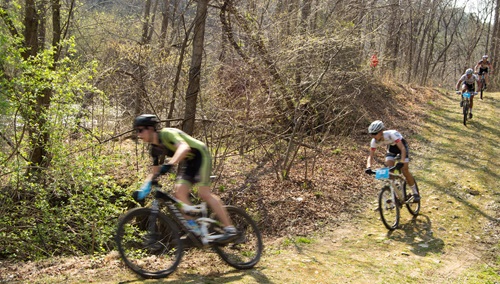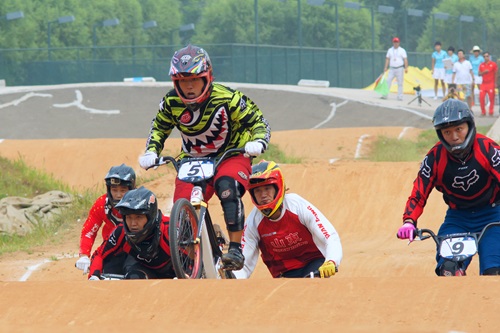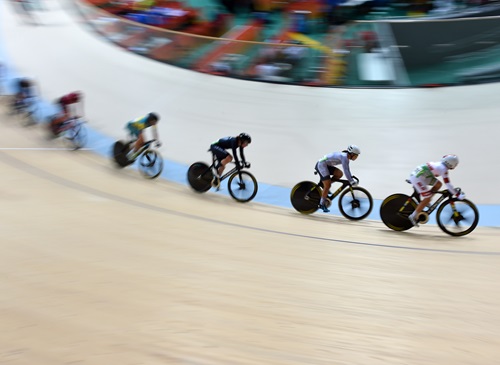
When the National Cycling League announced it had hit the pause button on its 2024 season, it was the latest symptom in a phenomenon bike group organizers say is a problem in this country: the failure of crowds (and also sponsors) to embrace competitive road cycling.
As Cycling Weekly notes, on the surface, the NCL, which debuted only a year ago, seemed to have it all: a spectator-friendly format, a cohort of all-star investors and city-specific teams. It brought the high-speed excitement of criterium racing to cities, along with a points-based format that ran throughout the entire race.
In fact, the series was intended to reignite American cycling fandom and reinvent cycling altogether. The 2023 season consisted of only three races (a fourth was cancelled amid a shakeup during the season) but those three were surrounded with much fanfare and publicity. Upon the conclusion of the series in August, the organization hailed its debut as a “tremendous success,” which left them “excited about the future of the league.”
Fast forward to spring 2024 when organizers announced a pause, effective immediately, including all rider contracts and salaries.
“While NCL will not field events or teams in 2024, the executive team and board of directors will focus on coming back stronger in 2025 by restructuring its business model within the current economic challenges facing the domestic and global cycling industry,” the announcement read.
According to Cycling Weekly, riders found out about the change in a four-minute-long Zoom call, and because of prior non-disclosure agreements, were unable to make any statements to, or discuss their reactions with, the press.
 But maybe a statement isn’t needed at all. The USA, unlike much of the rest of the world, has been slow to embrace road cycling as a competitive sport. And all the way back before the pandemic, symptoms of the problem were evident, with the cancellation of events like the Amgen Tour of California.
But maybe a statement isn’t needed at all. The USA, unlike much of the rest of the world, has been slow to embrace road cycling as a competitive sport. And all the way back before the pandemic, symptoms of the problem were evident, with the cancellation of events like the Amgen Tour of California.
“It’s clear in America we’re definitely lacking in big races, we lost with the Tour of California, Colorado, and Utah has been gone for the last couple of years,” U.S. National TT Champ, Lawson Craddock told reporters at VELO.
The USA also lacks velodromes; only 27 are available in this country, meaning many who want to pursue track cycling need to travel in order to train.
Another issue is that in the USA, bicycles are not regarded as transportation, the way they are in Europe. In fact, this article notes, there are outright barriers to that school of thought. This is an excellent analysis, including two great photos: one of a bike rack in the USA (largely empty) and another in Europe (bursting with bikes).
MinnPost states, "Bike riders in Europe aren’t just exercising, it’s not an “activity” of some kind; their bikes are integrated into their daily lives. You see very few road or racing bikes in Amsterdam for instance, and almost no specialized bike clothing. They just ride around."
The Washington Post notes that “After increased investments in bicycle infrastructure, big experiments with urban bike sharing, an explosion in electric-bike sales and an overall pandemic bike-buying boom, the latest news on bike commuting in the US from the Census Bureau’s annual American Community Survey is not impressive. An estimated 731,272 Americans used bicycles as their chief means of transportation to work in 2022, up from 2021 but down almost 75,000 from before the pandemic and 175,000 from the peak year of 2014.”
Indeed, commuter cycling hit a plateau by 2023, says Planetizen.
In the USA, children ride bicycles for fun (it’s a rite of passage to get that two-wheeler, after all) and adults ride them for recreation (and fitness as well) – but the thought of becoming a professional cycling athlete is uncommon. (The cycling component of triathlons is an exception to this rule.)
Global Sport Matters notes, “Road racing is the most recognizable form of professional cycling. It includes the world’s most famous race, the Tour de France. But even the Tour, the one race most Americans have heard of, is hardly a major event in the U.S.”
Except nobody bothered to tell the city of Charleston, West Virginia, where the USA Cycling Road Race Championships were scheduled.
“I fully anticipate there are going to be people, you know from kids on up to people in their 50s and 60s and 70s, who are going to see the athletes racing here in Charleston and say, ‘Oh my gosh I want to do that,'" said Tim Brady, president and CEO of the Charleston Convention and Visitors Bureau. "Really, that’s the exciting thing for me, that we are going to have a bunch of new people to take care of and get in and involved and excited about this sport that I love.”
The USA also sees competitive cycling at the Olympics, where BMX, mountain bike, track racing and road cycling are contested. But the Olympics and the Tour de France are the mainstays in terms of seeing competitive cycling in the mainstream media. Unless there are more events like the one in Charleston, American children do not get a chance to develop hero-worship for professional cycling athletes.
Currently, some of the top U.S. riders are training in Europe, according to VELO. Abroad, the article notes, races and travel are more cost-effective.
In an article in Medium, writer Peter Abraham posed the question, “American Bike Racing is Broken. Can it Be Fixed?” And the answer was yes, of course it could. It needed to focus on a few things, such as being more welcoming to beginners (who lack skills and speed) and minorities (who see nobody that looks like them).
“There… should be more no-drop, slower paced rides with leaders and an emphasis on fun and learning,” Abraham wrote. “And many cycling clubs completely fail here. Imagine a ski resort with only black diamond runs that wonders why more skiers don’t show up. That’s what lots of club cycling looks like. Clubs should be much more focused on bringing in new riders, women, people of color and young riders.”
The college scene, Abraham noted, is also “set up to fail,” since most cycling teams are really all-volunteer clubs made up of students who may not be able to afford equipment and who also have to organize and promote their team’s bike races. (Logistics for a bike race, including timing equipment, is expensive. Oh, and since it is naturally going to be the next question: 5K races can afford it because they are supported by entry fees and work with race directors who already have professional equipment.)
 USA Cycling’s CEO, Brendan Quirk, is dedicated to the growth of the sport, according to Medium, and has identified five goals:
USA Cycling’s CEO, Brendan Quirk, is dedicated to the growth of the sport, according to Medium, and has identified five goals:
- Re-energize American bike racing
- Expand and retain audience
- Deliver performance success
- Develop sustainable revenue streams
- Spearhead growth and diversity
Abraham notes, “The challenge is, how does he execute on all of these given the current trends in the sport? With limited resources, USAC can’t fix every problem. So, what do they focus on? And how do they balance the need to win medals now with the need to fill the pipeline and grow the sport at the grassroots level? I don’t have the answer, but he’ll only be able to succeed if he lines up enthusiastic support from all of his stakeholders. I’m rooting for him.”
It's not all doom and gloom, though, since cycling has grown in certain disciplines. Gravel racing is one of these. In fact, Global Cycling Network noted that 2024’s calendar is burgeoning, with races in nearly all 50 states. And, in fact, there are states that positively hang their hats on gravel grinder tourism, and on trail and mountain biking as a whole.
Global Cycling Network also notes, “America’s gravel scene has a lot to offer. With big landscapes, copious gravel roads and a high demand for getting out into nature, it is an exciting time for those who have been bitten by the gravel bug.”
More good news: BMX has grown nearly 65 percent over the last decade, according to PinkBike. USA BMX is committed to bringing up the next generation of riders and has a number of programs in place, including STEAM programs, scholarships, freestyle amateur events, the national series, the Olympics and new facilities built across the United States.
 Additionally, criteriums have been gaining in popularity (and in number) over the last few years. Typically held on a downtown, flat 1K circuit, the style lends itself to spectators and is instrumental in keeping the cost of logistics to a minimum. USA Cycling, in fact, launched a 2024 spring criterium schedule with four events, all based in the Southeast: Alabama, South Carolina, North Carolina and Georgia. At the same time, USA CRITS expanded to 11 races across the country. A profile of USA CRITS can be found here.
Additionally, criteriums have been gaining in popularity (and in number) over the last few years. Typically held on a downtown, flat 1K circuit, the style lends itself to spectators and is instrumental in keeping the cost of logistics to a minimum. USA Cycling, in fact, launched a 2024 spring criterium schedule with four events, all based in the Southeast: Alabama, South Carolina, North Carolina and Georgia. At the same time, USA CRITS expanded to 11 races across the country. A profile of USA CRITS can be found here.
Ravi Rajcoomar, co-founder of USA CRITS, notes that one event can have a substantial impact on a community.
“Our larger events can bring in between 30,000 and 40,000 spectators,” he says. “Not every market is like that, of course; and our smaller events average between 10,000 and 15,000 people. Most of our communities say it is one of their biggest days in terms of business and interest. We create that stadium feel for them. In our hometown race in Athens, Georgia, it’s on a par with an SEC home college football game, which is a pretty big deal.”

